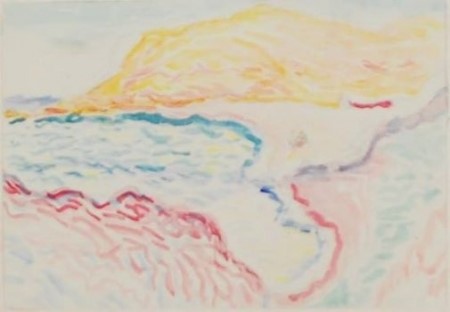Matisse
Bord del le mer Collioure
1923
Important work
This work is sold
ARTIST:
Matisse, Henri b. 1869 Le Cateau-Cambresis, France d. 1954 Nice, France
Title:
Bord del le mer Collioure, 1923 (after the watercolour of 1905), not signed, Ganymede blind stamp lower right, 1923
Technique:
Collotype, edition of 500
Paper:
Fine laid paper 17.4 x 25 cm sheet
Condition:
Excellent. The work is housed in a contemporary gold bulbous frame (see photo below) with archival matting and mounts
Realisation / Publication:
This collotype was made after the watercolour of 1905 by the master stencillist of the day, Daniel Jacomet. The watermark of the Ganymede Press can be found lower right
Provenance:
Private Dealer, Madrid, Spain
Why would Salon consider this an important work? When Matisse, along with his friend Andre Derain visited the coast near Andalusia in 1905, they produced some of the most striking works of art that came to define the movement known as Fauvism. Why? Both artists experimented with colour and light. Their visions of the coast, the sea and the surrounding landscape, were vivid and highly exaggerated, yet both Matisse and Derain were able to capture the essence of what they saw and convey this to the onlooker with clarity and a sense of realism; a word not usually used when discussing the Fauvists. One can, for example imagine ambling across the pebbled water line in Matisse’s Bord, toward picnickers seated ready for their beachside meal, seen centre right of the work. Both the sea and the coastline art distinct and finely rendered to accentuate the difference in elements. It is also worth considering that the collotype is now virtually defunct as a means of reproducing a work of art. The significance here is that in this sense, the work becomes a historical document; a testament to the work of the Ganymede press whose stamp can be seen bottom right. Although there is no evidence, collotypes were made usually with the artist present, or at least with the approval of the Estate in case of the artist passing. When Bord was made, Matisse had left behind elements of Fauvism that had defined him in the canon of early 20TH Century art history. Given this, and the closeness of the colours used in the collotype (when compared to the watercolour) it is not too much of a stretch to imagine Matisse present to advise the chromist on the colours, when the collotype was made. It is likely that he inspected the plate prior to printing, given that such work preceeded copyright law and exactness was what underscored this artistic practice. The meticulous and time consuming process involved in making of such a work, should be seen and is today, an art form in itself with high prices being paid in auction rooms internationally. Matisse’s watercolour (that inspired this collotype on offer here), was auctioned as recently as 2010 by Sotheby’s, realising some $70K US+ at sale. Salon’s collotype is inscribed with HM in pencil lower left, is NOT the artist’s monogram, with some pencil marking also on the reverse recorded were also recorded by the framer during the rehousing process, an applied to the back of the frame for future reference.
Email [email protected] to purchase.
